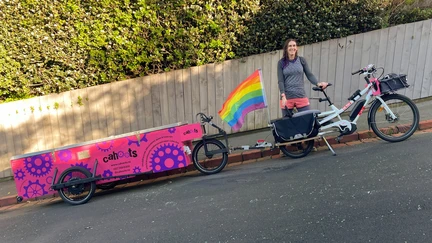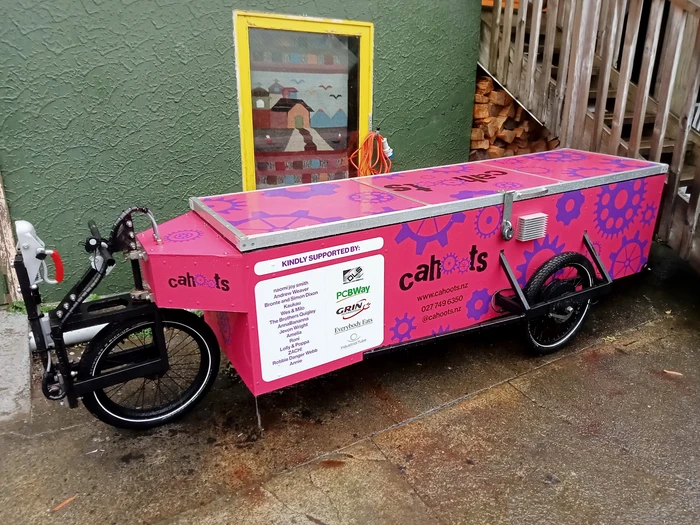Chatting with Cahoots: an interview with Jade Musther of social business, Cahoots. Part 1
We talk to Jade Musther, Cahoots, about building a business around social justice, bike powered trailers and queer advocacy in the trades.

When a tradie turns up for a job, most people would expect them to be driving a van or ute. Not so with self-described ‘Handy ma’am’ Jade Musther of Cahoots. Jade arrives on an e-bike towing a powered trailer containing all the tools needed for a job. You may have seen Jade and her bright pink CRAB trailer whizzing around the streets (and hills) of Wellington. WCL sat down to kōrero with Jade and learn more about the three pillars of the Cahoots kaupapa - social justice, queer trade advocacy, and bike advocacy.
Part 2 of this interview appears here
Photos have been provided courtesy of Cahoots.
WCL: Let’s start with a bit of background – tell us who you are and how you came to set up Cahoots.
Jade: I set up Cahoots out of the question “What do I do with myself?” I have a wide range of skills and a diverse background and I wanted to do something supporting social good. I also wanted to do something self-directed so that I had some control. I was doing bits and pieces to help people with projects. Some of those people couldn’t really afford to bring someone in and pay them to do the work. I already cycled everywhere and wondered “How do I pull this stuff together?” Cahoots was the answer to that.
WCL: Where did you gain your skillset?
Jade: For a long time I worked for a trust which is building an intentional community ecovillage. Within that scope I did and learned a lot of things. I learned about construction and about engineering things like water systems and power systems for off grid use. One of the things we were developing were scalable rural tech projects to decarbonize the rural space. Really climate change responsive projects. So all of these different threads led me to develop these different skills.
WCL: Now you tend to concentrate on the handy person stuff - the small building and engineering projects?
Jade: Yeah that's right. I do repair and maintenance projects. I really enjoy it when someone comes with a bit of a weird project. Building the trailers for Cahoots was one of those weird projects.
Cahoots is young and it would be great to talk about growth plans and things but I don’t know quite what direction it will take for me yet, personally.
There’s interest from different spaces and people who want trailers like ours so that could be a direction - continuing to develop bike technology.
WCL: When did you set up Cahoots?
Jade: Officially Cahoots was established in 2023 when I built the first Cahoots trailer and sort of soft launched. I did work around proof of concept and that was when I realised that the first (unpowered, unbraked) bike trailer was not going to cut it.
I wondered a few times whether it was a really bad move, you know, doing the whole bike powered tradie thing because it is a real transport and technological challenge. A purely bike powered trailer in Wellington, trying to haul tools around, does not cut it. When I was going out to look at a job, I was constantly thinking “What can I pare down? What tools can I not take with me?” and then of course I would need that tool.
So it came to either having to double down on the model and build a new trailer, or say “Actually this doesn't work”. We decided to double down. It kind of kicked off from there because that's when we started to get more public attention. Then we did the crowdfunding and we got the response from the wider community, a very solid “Yes this is great. This is what we want”.
WCL: Why the name Cahoots?
Jade: We spent a long time trying to come up with something that captured the diversity of the things that Cahoots was about.
It had become clear that Cahoots was about these three core beliefs, and how do you capture that in a name? We played around with long names and short names and it was really hard to get anything that felt like it encapsulated everything. Eventually someone suggested a longer name that had the word “Cahoots” in it and it kind of clicked.
It suggests community and collaboration and it also has a little cheeky edge as well. That edge is something I like because it’s like the queer experience, particularly in trades. But also what we’re doing with the sliding scale is subverting capitalism a little bit.
WCL: You’ve mentioned the three pillars central to the Cahoots kaupapa. Your website describes Cahoots as a “Sliding scale, bike powered, queer and trans run, practical community resilience and repair collective”.
That’s an interesting business model so let's unpack it bit by bit.
Starting with how your services are priced on a sliding scale, how does that work and why choose that model of charging?
Jade: It’s currently based on whether somebody has a Community Services Card because that is means tested.
We charge anybody with a community services card a half rate: that is offset by charging everyone else rate and a half. But there is a bit of a dead spot in the middle where you've got people who are employed but they're not on a particularly high wage. I do get people who contact me and we have these conversations and I end up having to say “Well we're probably not the right solution for you”. Over time we may have to figure out something because it means we're either working for more well off people or less well off people but not the folks in the middle.
WCL: Are you WINZ accredited?
Jade: They have an accredited supplier scheme and [applying for that] is one of the things on my to do list.
WCL: Next part – Bike powered – why choose pedal power for your business transport?
Jade: I bike everywhere because I have a visual disability which means I am not allowed to drive. If I am to do handyperson work I have to be able to transport myself and tools without driving a ute. So the bike and trailer is a natural progression from that. And of course that’s appealing to folks for being more sustainable and climate-resilient.

WCL: Seguing into a discussion about the CRAB trailer: is CRAB an acronym?
Jade: It’s a bit of a terrible acronym but it stands for Cahoots Revved And Braked. Revved because I was looking for synonyms for powered or motorised, I was having trouble getting things to fit into an acronym.
WCL: You designed and built the trailer after crowdfunding its build. Tell us a bit about your design process. Is it an original design or have you adapted other technology?
Jade: It’s an original design. It’s a three wheel trailer, two at the back and one at the front. The one at the front being attached to the drawbar, so that it pivots with the drawbar.
Bike trailers have been built that way. That exists as a paradigm. Beyond that it was designed from the ground up.
I started by figuring out the gross dimensions so that I could design the frame and look at the loading and the weight capacity. I worked with a Canadian company to specify the needs for the motor generators on the rear wheels. Once [they had provided] some numbers I could feed that into the chassis design. Then I looked at the power of the motors, the torque, braking and how this compared with what I was trying to achieve.
The loading of the trailer took a little bit of finite element analysis, which is where you simulate in software the loading on a structure to see whether it needs more or less steel in a frame, whether it would handle the loads necessary.
And then I had to solve all the other little problems. Work out what the electronics had to do. What the drawbar had to look like so it could accommodate the load cell that is the input into the electronics that in turn determine how much to power or braking to apply to the wheels and all that kind of stuff.
The physical construction is one major aspect and the electronics is another. We’re trying to use as many off the shelf parts as possible. Most of the trailer chassis is constructed from standard steel. There’re some laser cut parts that make up the front end of the trailer and the pivoting of the wheel and drawbar. Then off the shelf bearings and off the shelf brakes which are then modified. And some customised electronics to make it all work.
Link here to video of Jade talking about the trailer design
WCL: Have you patented your design? Protected what you have learned?
Jade: My understanding is that there is probably not a lot in what I have done that is protectable because it is a combination of existing technologies. The only powered, braked trailer I am aware of has been built by a German company. As far as I can tell they’ve only made a handful. I’m not sure there is much that is protectable and patents are very expensive so I have to ask what is the return on that. I want to promote the use of this kind of tech rather than protect it.
Having said that most of what I’ve done is more protectable in a trade secret capacity. More like my experience and understanding of the systems and things that I tried and then had to adapt. The reason someone would come and get me to build one is because they would be silly to go elsewhere and try and build it themselves. They’d have to do their own R&D and they’d lose money on that (like Cahoots did).
The trailers are expensive and the demand isn’t that high yet. Even the demand for unpowered bike trailers is not that high but hopefully we’ll see more in the future. It’s all stuff I’m talking to people about - what this process might look like and what grant funding might be available to do more development in this capacity. We would need to to optimize production because a lot of it was very manual and if I build another one for a client it will still be quite manual. A lot of it can be streamlined, can be more automated. Watch this space.
WCL: What’s your geographical capacity?
Jade: Most work is south of Kaiwharawhara but I definitely can go up to the Hutt and over to Johnsonville, Newlands, Porirua. Travel time is longer with the trailer. One of the things that is interesting about doing this kind of work from a bike is that things are a little different. It might mean that when it’s raining, and I turn up at your house, I would appreciate it if you could provide me space to get changed into my dry working clothes. That’s the kind of thing I need customers to expect.
Parking is easier – I can pretty much get away with parking in lots of places you might otherwise have to reject [in a vehicle]. Realistically if I‘m picking up a part I can just leave the bike out front and pop in quickly.
So swings and roundabouts – for the central suburbs it’s not significantly longer or significantly different from any other mode of transport.
This is part 1 of a two part interview. Part 2 will be published next week.